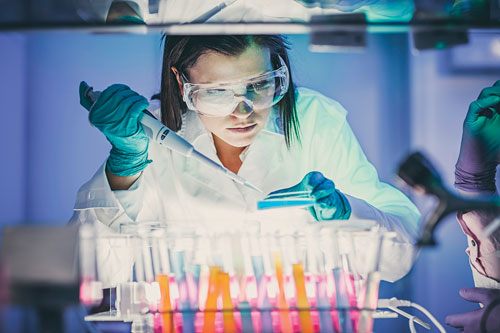GEN recently spoke with Ryan Bomgarden, PhD, senior R&D manager at Thermo Fisher Scientific, about the many advances being made in understanding protein-protein interactions as well as what the future holds.
GEN: The Thermo Fisher Scientific website states: “Pull-down assays are ideal for studying strong or stable interactions or those for which no antibody is available for co-immunoprecipitation.” Could you provide some examples of specific analyses that have been exploited by investigators for studying such interactions?

Bomgarden: It is first worth noting the difference between pull-down assays and immunoprecipitation. While pull-down assays use a protein or chemical tag for target protein binding, immunoprecipitation uses an antibody to bind target protein antigen. Besides this difference in target protein capture, they are virtually the same process. The overall idea is to enrich the target protein of interest (the bait) to fish for the interacting protein (the prey).
Pull-down assays are preferred for recombinant proteins where fusion tags (such as GST, HIS) or chemical tags (such as biotin) are used as affinity groups for capturing bait that binds to prey proteins. GST, MBP, and other large fusion tags are ideal for solubilizing smaller proteins/peptides which are used for protein-protein interaction domain mapping. Chemical tag pull-downs are popular for techniques where biotin is transferred to proteins via protein-protein interactions (such as APEX, TSA, BioID, or sulfo-SBED).
GEN: Are there particular classes or types of proteins that are favored by pull-down assays versus co-immunoprecipitation?
Bomgarden: Pull-down assays are preferred for recombinant proteins or proteins where there may not be good IP-validated antibodies. There are some proteins that cannot be expressed well as a recombinant protein, such as membrane proteins.
Additionally, pull-down assays would be preferred when a small domain or peptide recombinant domain is used as the target protein for mapping of protein interactions. These small proteins or peptides may have poor solubility or may not be good antigens for enrichment using immunoprecipitation techniques, necessitating the use of pull-down assays instead.
GEN: Are there alternatives to the use of mass spectrometry for experimental analysis of protein-protein interaction? What would be the relative advantages and disadvantages of such procedures?
Bomgarden: Proteomic-based mass spectrometry (MS) is the most versatile and comprehensive method for discovering novel protein interactions for specific target proteins. The advantages include capture from endogenous systems (using IP-MS and APEX), mapping of interaction surfaces (such as HDX, FPOP, or crosslinking), identification of PTMs and isoforms, and determining stoichiometry (using native MS). Most MS protein-interaction applications require no antibodies or only one for IP-MS, unlike most immunoassay-based approaches which require two specific antibodies (such as co-IP Western blotting, ELISA, Luminex, or PLA).
In addition, discovery bottom-up proteomics does not require any prior knowledge of interactors and can identify multiple interactors within protein complexes.
Other than the accessibility of instruments, some disadvantages of mass spectrometry include poor sensitivity for low abundant proteins and interference from background proteins which bind to affinity resins used in IP-MS.
Recombinant library screening approaches (such as yeast 2-hybrid or phage display) can also be used to find and map protein interactions, but typically require expression in non-native systems. In addition to false positives, some proteins (larger, membrane) are not easily expressed in these assays. Mammalian 2-hybrid techniques have address some of these issues but are still primarily limited to studying pair-wise interactions.
GEN: Computational methods for protein-protein interaction analysis are organized into three categories, including cluster-quality-based methods, node-affinity-based methods, and ensemble clustering methods. Could you please discuss some typical applications of these methods and which ones may be the most appropriate?
Bomgarden: There have been some major advancements using algorithms to model global datasets and predict protein-protein interactions. Many of these involve organizing interaction data into clusters or nodes to generate a network with topology that can be used to group proteins into complexes or by function.
In the future, there might be further opportunities to integrate these protein interaction datasets with others, such as data related to protein subcellular localization, proximity (BioID or APEX), structure.
GEN: Do different post-translational modifications, phosphorylation, acylation, glycosylation, and ubiquitination, present special challenges when undergoing protein-protein interaction analysis?
Bomgarden: Post-translational modifications (PTMs) are extremely important to the study of protein interactions. Some protein modifications are required for protein interactions, such as SH2-domain proteins binding to receptor tyrosine kinase phosphorylation sites. Others modulate the protein interaction, such as acetylation of histones bound to DNA. Therefore, studying protein interactions in native systems expressed at endogenous levels is best to maintain and identify relevant PTMs for protein interactions.
In the past, most protein interaction studies were not conducted in endogenous systems, but by expressing proteins in, for example, yeast. Those systems would lack PTMs, or the correct PTMs, which could lead to false negatives or false positives in regard to protein-protein interactions. The primary way to identify or measure PTMs today is mass spectrometry, which enables the analysis of the various protein isoforms and PTM stoichiometry.
GEN: In the late 1990s, protein function analysis shifted from single proteins to protein-protein interactions. In this intervening period, many advances have been made in our understanding of proteomics and protein-protein interactions. How has this affected your approach to the study of protein-protein interactions?
Bomgarden: Over the past three decades, there has been a transition in studying specific target protein interactions in vitro to studying protein complexes and global interaction networks in vivo. This transition has been facilitated by new technologies which have improved the sensitivity and specificity of protein identification and abundance measurements. In addition, more recent technologies have also provided additional insights on protein complex structure, stoichiometry, and dynamics. As our knowledge-base of interactions has increased over the years, significant progress has been made using software tools to predict and model protein interactions.
GEN: What are some of the specific contaminants that are present in protein-protein interaction studies, and how does your methodology eliminate them?
Bomgarden: For pull-down assays using recombinant proteins, contaminants can come from nonspecific binding to affinity resins or impure recombinant bait proteins. Nonspecific binding to affinity resins is also a source of contaminants for antibody-based techniques. In addition, antibodies with poor specificity may also bind to other proteins contributing to high background. Using IP-verified antibodies and resins (which have low-protein binding or passivated surfaces) is the best way to minimize contaminant proteins.
Contaminant proteins which contribute to part of false positive interactions can be eliminated using experimental approaches, such as reciprocal pull-downs (or immunoprecipitations) and orthogonal methods to verify the proteins present in a particular complex (such as, IP-MS, imaging, or structural analysis).
Background contaminants can be eliminated easily depending on the technology used. With mass spectrometry, background proteins that are present in more than one pull-down assay can be eliminated simply by using the appropriate software. However, if antibodies are used the only way to eliminate false positives is to use a better antibody or reagents.
GEN: How does Thermo Fisher view the future of studying protein interactions
Bomgarden: The company supports all of the classic biochemistry tools used to study protein-protein interactions in vitro, including co-IP methods and pull-down assays. However, the company is now focused on advanced technologies in this area, namely the mass-spectrometry-based global profiling for protein-protein interactions.
One focus is using crosslinking in combination with MS to essentially freeze the proteins interacting in a cell, then enrich and profile them in their native condition without an antibody. There are applications available which can also quantify changes in interactions using crosslinking and tandem mass tags, to measure changes in protein interactions more globally.
While studying pair-wise interactions can be important in some scenarios, this technology is enabling us to move towards global analyses to examine protein networks. Using MS, researchers can identify multiple isoforms in different cells or disease cases, and determine how their interactions change. Looking at these interactions dynamically and in different localizations through a global approach is the future of this field of study.
There are moreover several techniques opening up new possibilities in the study of protein-protein interactions. For example, with the availability of commercial antibodies increasing over the years, researchers moved away from recombinant protein expression and purification used in pull-downs in favor of immunoprecipitations. However, a newer technique has emerged that uses recombinant protein expression facilitate protein biotin transfer for streptavidin pulldown, but is now done in vivo.
Rather than growing bait proteins in bacteria, it’s possible to overexpress a fusion of that protein with an enzyme in mammalian cells, before adding a biotin tag or probe. The enzyme will activate the biotin in a localized area, enabling the study of not only the direct interactions of the protein of interest, but also its proximity to other proteins, so that researchers can effectively create a map of the protein’s location. This approach is used in methods such as BioID and APEX.
Another technique is applying global proteomics to study subcellular localization. With this method, researchers can follow all the proteins that move from the different cellular compartments such as from membrane to the nucleus of a cell, effectively tracking protein complexes and interactions at a global scale. The future is integrating protein localization data with the protein interaction network data, to provide an additional dimension relating to location and proximity.
From Thermo Fisher’s perspective, there are two significant focus areas for improving studying protein interactions. One is improving the mapping and verification of protein interactions, which are largely built on binary static, interaction information. This can be undertaken using structural biology tools, such as native MS, cryo-EM and proteomic-based, crosslinking MS. These techniques are complementary to traditional protein-protein interaction methods and are enabling researchers to better understand how protein complexes are put together.
The second focus is measuring changes in protein complexes over time and with treatment. Tandem mass tags (TMT) is one technology that measures changes of protein location and abundance over time on a global scale using mass spectrometry. This adds a further dimension to protein interaction information, enabling researchers to build a more complete picture and utilize dynamic data.



